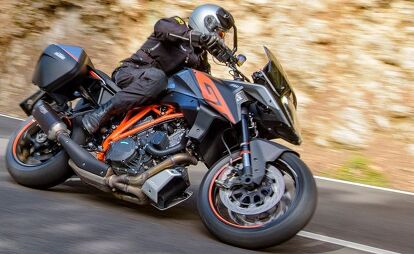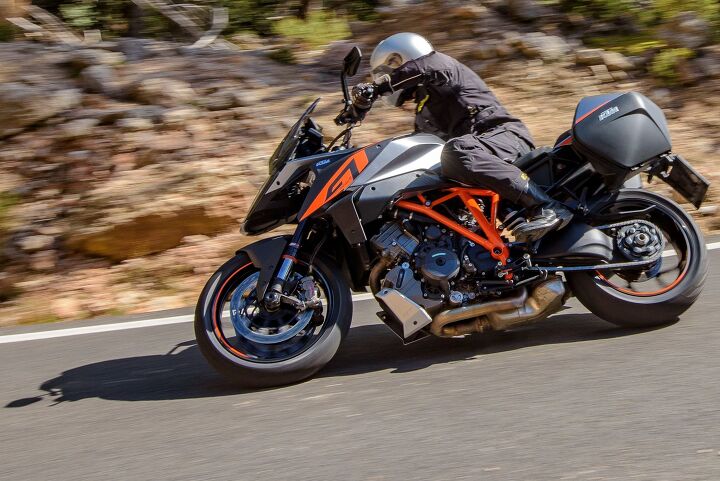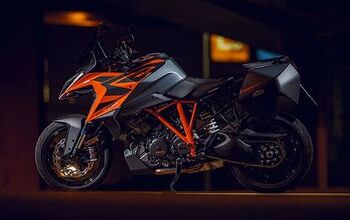2017 KTM 1290 Super Duke GT First Ride Review
The state of the art of ultra-sporty sport-tourers
We probably didn’t need to travel to Spain to find out the Super Duke GT is a terrific motorcycle. After all, it’s based on our 2014 Motorcycle of the Year, the wonderfully capable and funtastically fast Super Duke R. What was yet to be discovered was how the changes from R to GT worked to transform the hooligan roadster into a proper grand tourer.
2017 KTM 1290 Super Duke GT
| Engine | 19.75/20 |
| Suspension/Handling | 14.5/15 |
| Transmission/Clutch | 9.5/10 |
| Brakes | 10/10 |
| Instruments/Controls | 4.25/5 |
| Ergonomics/Comfort | 9.25/10 |
| Appearance/Quality | 9.0/10 |
| Desirability | 9.5/10 |
| Value | 8.75/10 |
| Overall Score | 94.5/100 |
2014 Ultimate Streetfighter Finale
But it would be unfair to think of the GT as just an R with a windscreen, as it underwent a cornucopia of changes: KTM claims the GT’s development required more than 30 man-years of work. That might sound a bit hyperbolic until all the upgrades are added up.
The GT brings a host of electronics previously unavailable on the SDR, including a semi-active suspension, Cornering ABS, cruise control, heated grips and KTM’s first quickshifter. The GT also receives as standard equipment electronic tire-pressure monitoring, self-canceling turnsignals and LED cornering lights.
The Super Duke R is blessed with one of the greatest motorcycle engines of all time, and the GT gets a revised version of KTM’s 1301cc V-Twin engine. It’s purported to push out the same 173 crank horsepower and 106 lb-ft of torque as the SDR, but it hits its torque peak 1000 revs sooner (6750 rpm) and is said to have no less than 86 lb-ft available at just 3250 rpm. Credit a new cylinder head with narrower intake ports and reshaped combustion chambers.
Moreover, the engine was required to meet tough new Euro 4 emissions regulations (40% less pollution than Euro 3, according to KTM’s Erich Friedl), so the GT has a new pre-muffler and catalyst under the engine, plus a new stainless steel muffler with internal flapper valve that boasts seven maps to moderate noise emissions for all six gears plus neutral. Friedl says that tuning in smooth drivability while meeting Euro 4 emissions is extremely challenging.
All that said and we haven’t yet gotten to the new bones of the GT. The headlight is pushed forward and mounted on a nylon composite bracket that also supports the sharply angled fairing, windscreen and the VDO instruments we’re accustomed to seeing on KTMs. Fuel capacity is upped from 18 liters to tour-worthy 23 (6.1 gallons). At the rear, a bespoke subframe is built from aluminum tubes, a structure that supports a longer pillion saddle and integrated mounts for the saddlebags developed internally by KTM rather than using off-the-shelf bags. The panniers are optional in Europe but standard in North America.
Ergonomically, the GT’s 25mm-wider handlebar places hands 5mm higher than the SDR. Further adjustments are available by reversing the handlebar clamp, which brings the bar ends 12mm closer to a rider, and the clamp also has an alternate mounting hole that provides another 10mm of adjustment. And, as with any one-piece handlebar, it can also be rotated in its clamp to suit individual taste. Footpegs for both pilot and pillion have been lowered for extended legroom. Nubs for shifter and brake pedal can be set to three positions to suit feet of different sizes, and both hand levers are adjustable for reach.
Lorenzo’s Land
Mallorca is an island off the east coast of Spain known to race fans as the home of three-time MotoGP world champion Jorge Lorenzo, and it’s also a kissing cousin to the party island of Ibiza. It now adds host of the Super Duke GT launch to its C.V. Happily for our group of hooligans, a dearth of traffic enforcement seems to be part of the charming island’s many endearing features.
The Super Duke GT is a fairly gangly steed, with a seat perched 32.9 inches from the ground. But considering it houses 1301cc of power, the bike is remarkably manageable. Clutch pull is surprisingly light for being able to handle such a stout motor, and the precise transmission requires just a soft nudge to navigate through the gears.
I began our ride in Sport mode and with the WP semi-active suspension toggled to its Comfort setting, both fairly easily navigable once the system is learned via the four buttons on the left switchgear. Sport mode has reasonably smooth throttle response and also allows modest wheelies if they’re smoothly pulled. The quickshifter programming proves to be excellent for street use, adapting to the way the bike is ridden by incorporating ride-by-wire throttle control, rather than just simply cutting fuel and spark, when the internal mechanism is nudged.
The suspension’s Comfort mode is amazingly plush in normal use and automatically dials in firmer damping when ridden more aggressively. It’s fine up to about a seven-tenths pace when it begins to feel too loose. WP claims its active damping valves adjust within just 10 milliseconds.
Comfort and Street modes have anti-dive programming that keep the longish-travel suspenders (4.9 inches up front; 6.1 out back) from pitching awkwardly. Surprisingly, Sport mode doesn’t use the anti-dive strategy of the other modes, causing noticeably more front-end dive. This has the benefit of steepening the rake angle and delivering slightly easier turn-in response, but I preferred the even-keel balance of Street mode. The Sport mode has baseline damping similar to the SDR but automatically adjusts itself through a range depending on riding style, speed, etc.
When talking about any Super Duke, meaty engine performance is always part of the story, and so it is with the GT. Big power is packed from top to bottom, pulling smoothly and strongly from 3500 rpm, allowing a rider to run a gear or even two taller than what might be optimal. The knockout punch comes into play at about 6500 revs when a tidal wave of torque threatens to loft the front end without additional provocation in the bottom three gears.
The V-Twin’s exhaust note is sweet and mean, with a stimulating burble on overrun. The noise from the titanium Akropovic slip-on doesn’t sound much different from the OEM muffler. Vibration from the 75-degree Twin can get intense at high rpm, but it’s not an issue at cruising speeds. It’s spinning at 5000 rpm at 85 mph. The footpegs do without vibe-defeating rubber inserts, which shows that problematic vibration wasn’t evident during the GT’s developmental stage.
Smooth deceleration is aided by a slipper clutch and by the system combining a bit of rear brake when the fronts are applied; actuating the rear brake doesn’t apply pressure to the fronts. Further help can be provided by the optional ($200) Motor Slip Regulation system which slightly lifts the throttle plates to prevent the rear wheel from locking during sloppy downshifts. MSR levels are, like TC, tied to the three ride modes, so they can’t be set independently to suit rider preference.
And that’s part of one of the GT’s few shortcomings. Competitors from Europe allow independent adjustments of most of their electronic rider aids, but KTM links them to the ride modes. So, for example, if you prefer the throttle response of Street mode, you’re stuck with its associated TC setting that is too intrusive for my tastes and pretty much nullifies any wheelies.
Additionally, traction control and MSR are linked, so if you want the TC off, you’ll have to also deal with no MSR. Meanwhile, Ducati typically provides eight levels of TC, which can be set independently, and three levels of Engine Brake Control which can be set individually. KTM allows a rider to switch off TC, which is nice if, say, you’re a wheelie hound, but it always switches itself back on when the engine is shut off, even when leaving the key switched on, necessitating another trip through the menu system.
A potential foible for traditional sport-touring riders is the GT’s wind protection. While the windscreen’s adjustment can be conveniently done on the fly to seven positions, it comes up short on coverage compared to a typical sports tourer. With the screen set in its highest position, wind hits me (at 5-foot-8) firmly at shoulder height.
Ergonomically, the GT’s layout is near ideal for my body and preferences. I liked the slight forward lean that feels sporty but places almost no pressure on my wrists. the one-inch wider handlebar provides the leverage to quickly bend the GT into corners both slow and fast. Legroom is plenty adequate, and the seat never caused discomfort. Long-distance riders might want to consider springing for the accessory comfort seat that coddles a butt in plushness and includes a three-position heating element. It comes at the cost of being about 10mm higher and a price yet to be determined.
Standard features that deserve praise are the handy tire-pressure-monitoring system that supplies readouts in the LCD menu screen and includes a warning light on the primary screen if pressures drop critically low. We also appreciate the inclusion of self-canceling turn signals that automatically switch off after 10 seconds (the clock ceases counting when the bike is stopped) or 150 meters, whichever comes first. Optional Hill Hold Control ($225) engages and releases smoothly and is a nice feature for anyone with short legs or who is carrying a passenger or heavy load. Oddly, it switches itself off and releases the brake after five seconds.
And then there’s electronic cruise control which we’ve come to regard as necessary equipment for any bike designed for touring use. The KTM’s can be set in third gear or above and is noteworthy for allowing set speeds to be as high as 125 mph!
Speaking of high speeds, it’s worth mentioning KTM has established a speed limit for riding the bike when equipped with saddlebags. If you recall from our epic 9-bike Sport-Adventure shootout last year, we experienced some weave when caning the 1190 Adventure and 1290 Super Adventure at speeds above 100 mph when fitted with panniers. For the GT, KTM says speeds should be kept below 113 mph with the bags. I was able to exceed 125 mph without any stability issues. No, I didn’t attempt to set the cruise control! As with the SDR, the GT is equipped with a WP steering damper.
While the GT’s MSRP hasn’t yet been set, it’s expected to retail right around the $20,000 mark when it becomes available in the U.S. in September or October. At that price, it’ll be about $2800 more dear than its older brother. And while one certainly could tour on a Super Duke R by tossing on some bags and a windscreen to create a facsimile of the GT, you’d have to do without highly desirable features like active suspension, cruise control, adjustable wind protection and tire-pressure monitoring.
Ultimately, the Super Duke GT’s performance capabilities – engine, chassis, brakes, electronics – vault it to the top of the list of ultra-sport sport-tourers. KTM continues on its impressive roll to solidifying itself as a leader in motorcycle excitement.
2017 KTM 1290 Super Duke GT
+ Highs
- A motor as good as they get
- Comprehensive suite of electronics
- Quickest lap times of sport-tourers
– Sighs
- Electronic rider aids not independently adjustable
- Minimal wind protection for the S-T class
- Instruments looks plain for a $20k motorbike
2017 KTM 1290 Super Duke GT Specifications | |
|---|---|
| Engine type | 2-cylinder, 4-stroke, V 75° |
| Displacement | 1,301 cc |
| Bore/stroke | 108/71 mm |
| Power | 127 kW (173 hp) @ 9,500 rpm |
| Torque | 144 Nm (106 ft-lb) @ 6,750 rpm |
| Compression ratio | 13.2:1 |
| Starter/battery | Electric starter/12V 12Ah |
| Transmission | 6 gears |
| Fuel system | Keihin EFI (throttle body 56 mm) |
| Control | 4 V/DOHC |
| Lubrication | Pressure lubrication with 3 Eaton pumps |
| Engine oil | Motorex, SAE 10W-50 |
| Primary drive | 40:79 |
| Final drive | 17:38 |
| Cooling | Liquid cooling |
| Clutch | PASC slipper clutch, hydraulically operated |
| Engine management/ignition | Keihin EMS with RBW and cruise control, double ignition |
| Traction control | MTC (3-Mode, disengageable) |
| Frame | Chromium-Molybdenum-Steel trellis frame, powder coated |
| Subframe | Chromium-Molybdenum-Steel trellis, powder coated |
| Handlebar | Aluminium, tapered, Ø 28/22 mm |
| Front suspension | WP Semi-active Suspension USD Ø 48 mm |
| Rear suspension | WP Semi-active Suspension Monoshock |
| Suspension travel front/rear | 125/156 mm |
| Front brake | 2 x Brembo Monobloc four piston, radially mounted caliper, brake disc Ø 320 mm |
| Rear brake | Brembo two piston, fixed caliper, brake disc Ø 240 mm |
| ABS | Bosch 9ME Combined-ABS (incl. Cornering-ABS and super motomode, disenengageable) |
| Wheels front/rear | Cast aluminium wheels 3.50 x 17”; 6.00 x 17” |
| Tires front/rear | 120/70 ZR 17; 190/55 ZR 17 |
| Chain | X-Ring 5/8 x 5/16″ |
| Silencer | Stainless steel primary and aluminium secondary silencer |
| Steering head angle | 65,1° |
| Trail | 107 mm |
| Wheel base | 1,482 ± 15 mm |
| Ground clearance | 140 mm |
| Seat height | 835 mm |
| Tank capacity | approx. 23 liters/3.5 liters reserve |
| Dry weight | approx. 205 kg |
More by Kevin Duke









































































































































Comments
Join the conversation
"a new pre-muffler and catalyst under the engine, plus a new stainless steel muffler with internal flapper valve that boasts seven maps to moderate noise emissions for all six gears plus neutral" - Yuck - no way, I'm out!
just for reference, I'm 6'4" and recently sat on the GT. my knees won't sit below the cut out of the gas tank. I'm pretty disappointed. It was a bike I was really interested in. I'm pretty proportional, just tall, so if you're tall or have long legs you may have issues as well.